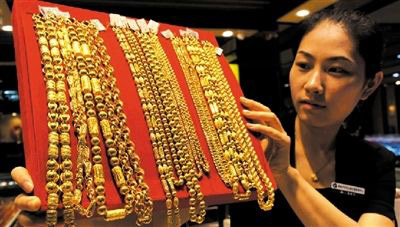This year's unexpected rebound in gold prices has revived those jewellery and trinkets that are not liked, but in the furnace. Often more than one-third of the world's gold supply comes from recycled metals, but during the first three years of the market's depression, the pawnshops and goldsmiths' purchases have been slowing. Everything has changed now. As gold prices are expected to hit a larger annual increase in 2010, more and more people are selling old jewellery, and recyclers are also expanding their production capacity. Jewelers have found that their business has changed. Mark Williams, owner of Farringdons jewelry store in Hatton Gardens, London, said in an interview with Bloomberg: "We are buying more now than gold sold. Whenever gold prices rise, and the media When Daxie reports, people will rummaging through the cabinets and searching out all the small things that they didn't like very much, and then bring them to us." Almost all the gold mined in the past is still circulating in one form or another, so recycling is an important source of supply. According to the World Gold Council (WGC) data, in 2015, as gold prices plunged 45% from the 2011 record high, the amount of gold returned to the furnace hit an eight-year low. According to Forbes, in the first half of 2016, the supply of gold from recycling was 686.7 tons, a record high in the first half of 2012. WGC said: "We have recently conducted a large-scale survey and found that high gold prices are considered to be an important factor in whether or not to send gold jewelry to recycling. Gold prices have risen among respondents who have sold gold jewelry in India and China. It is the reason why it is raised more (27% and 43% respectively)." So far this year, the price of gold has risen by 26%. In July, the price of gold hit a two-year high of $1,375 per ounce and set a larger first half increase since 1974. However, the rise in gold prices has also affected people's demand for gold jewelry. According to WGC data, demand for gold jewellery fell 14% in the second quarter of 2016 due to gold hitting record highs, and total quarterly demand hit a low level since the second quarter of 2010. WGC's "Golden Demand Trend Quarterly" shows that India and China, the two largest gold jewellery markets in the world, have led the downward trend in demand, and the third is the Middle East. At the same time, demand in the United States and Iran has improved. In dollar terms, demand for gold jewellery in the first half of 2016 was $36.3 billion, the lowest level since 2010. Demand for gold jewellery in the second quarter of this year was 444.1 tons, the lowest quarter since 2010. Demand for the first half of this year fell by 185.5 tons year-on-year, of which 149.4 tons were due to weaker demand from India and China. Consumers are increasingly favoring fashion, unique, and design 18k gold or gemstone jewelry instead of traditional 24k gold jewelry. WGC said: "Given the 18k gold jewelry consumers are younger generation, this trend is likely to continue. Our survey shows that more than 1,000 respondents who bought gold in 2015, 18 to 30 years old People who love 18k gold are better than 24k gold (39% and 25% respectively)." Men's Clothing ,White Undershirt,Long Sleeve Tshirt,Hoodie Jacket For Men Ningbo Liyuan Garment , https://www.liyuangarment.com